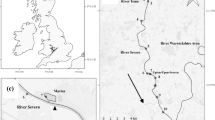Abstract
The distribution of Littorina irrorata Say on a low-energy barrier beach on the northern Gulf of Mexico is described, and correlated with the presence of Spartina alterniflora and other plants in the upper intertidal zone. The movements of 66 individually tagged snails were followed in the S. alterniflora zone for an average of 226 days, during which time an average of 10.6 positions were recorded per snail. The snails travelled an average total path distance of at least 995 cm, but due to contorted paths, ended up an average resultant distance of only 399 cm away from their original positions. They moved an estimated resultant distance of approximately 20 to 25 cm per activity period. Despite a slight offshore movement during the fall and winter, the snails moved more parallel to the shoreline than perpendicular to it.
Similar content being viewed by others
Literature Cited
Batchelder, C.H.: Migration of Ilyanassa obsoleta, Litorina litorea and Litorina rudis. Nautilus 29, 43–46 (1915)
Batschelet, E.: Statistical methods for the analysis of problems in animal orientation and certain biological rhythms, 57 pp. Washington, D.C.: American Institute of Biological Sciences 1965
Bequaert, J.C.: The genus Littorina in the Western Atlantic. Johnsonia 1(7), 1–27 (1943)
Berry, A.J.: Some factors affecting the distribution of Littorina saxatilis (Olivi). J. Anim. Ecol. 30, 27–45 (1961)
Bingham, F.O.: the influence of environmental stimuli on the direction of movement of the supralittoral gastropod Littorina irrorata. Bull. mar. Sci. 22, 309–335 (1972a)
— Shell growth in the gastropod Littorina irrorata. Nautilus 85, 136–141 (1972b)
— Several aspects of the reproductive biology of Littorina irrorata (Gastropoda). Nautilus 86, 8–10 (1972c)
— The mucus holdfast of Littorina irrorata and its relationship to relative humidity and salinity. Veliger 15, 48–50 (1972d)
Caldwell, D.K.: Notes on the crown conch, Melongena corona. Nautilus 72, 117–122 (1959)
Clifton, H.E., C.V.W. Mahnken, J.C. VanDerwalker and R.A. Waller: Tektite 1, man-in-the-sea project: marine science program. Science, N.Y. 168, 659–663 (1970)
Dexter, R.W.D.: Observations on the local movements of Littorina litorea (L.) and Thais lapillus. Nautilus 57, 6–8 (1943)
Federighi, H.: Studies on the oyster drill (Urosalpinx cinerea, Say). Bull. Bur. Fish., Wash. 47, 85–115 (1931)
Gallagher, S.B. and G.K. Reid: Reproductive behavior and early development in Littorina scabra angulifera and Littorina irrorata (Gastropoda: Prosobranchia) in the Tampa Bay Region of Florida. Malac. Rev. 7, 105–125 (1974)
Gowanloch, J.N. and F.R. Hayes: Contributions to the study of marine gastropods. I. The physical factors, behaviour and intertidal life of Littorina. Contr. Can. Biol. Fish. 3, 135–165 (1926)
Hall, J.R.: Intraspecific trail-following in the marsh periwinkle Littorina irrorata Say. Veliger 16, 72–75 (1973)
Hamilton, P.V.: Predation on Littorina irrorata (Mollusca: Gastropoda) by Callinectes sapidus (Crustacea: Portunidae). Bull. mar. Sci. 26, 403–409 (1976)
Holliman, R.B.: Larval trematodes from the Apalachee Bay area, Florida, with a checklist of known marine cercariae arranged in a key to their superfamilies. Tulane Stud. Zool. 9(1). 2–74 (1961)
Kojima, Y.: The relation between seasonal migration and spawning of a periwinkle, Littorina brevicula (Phillipi). Bull. mar. biol. Stn Asamushi 9, 183–186 (1959)
Kurz, H. and K. Wagner: Tidal marshes of the Gulf and Atlantic coasts of northern Florida and Charleston, South Carolina. Fla St. Univ. Stud. 24, 1–168 (1957)
Lambert, T.C. and J. Farley: The effect of parasitism by the trematode Cryptocotyle lingua (Creplin) on zonation and winter migration if the common periwinkle, Littorina littorea (L.). Can. J. Zool. 46, 1139–1147 (1968)
Magalhaes, H.: An ecological study of snails of the genus Busycon at Beaufort, North Carolina. Ecol. Monogr. 18, 377–409 (1948)
Moore, H.B.: The biology of Littorina littorea I. Growth of the shell and tissues, spawning, length of life and mortality. J. mar. biol. Ass. U.K. 21, 721–742 (1937)
Newcombe, C.L. and S.A. Gould: Growth indices of Littorina irrorata. II. Width, shell weight, fresh and dry weights of body parts. Biologia gen. 13, 474–481 (1937)
Newell, G.E.: The behaviour of Littorina littorea (L.) under natural conditions and its relation to position on the shore. J. mar. biol. Ass. U.K. 37, 229–239 (1958)
Pettitt, C.W.: An indexed bibliography of the family Littorinidae (Gastropoda: Mollusca), 36 pp. Manchester, England: Manchester Museum Publications (NS4. 74) 1974
Phillips, B.F.: The population ecology of the whelk Dicathais aegrota in Western Australia. Aust. J. mar. Freshwat. Res. 20, 225–265 (1969)
Phillips, N.E. and C.L. Newcombe: Growth indices of L. irrorata. I. Width, length, peristome width and volume. Biologia gen. 13, 465–473 (1937)
Sindermann, C.J.: Ecological studies of marine dermatitis-producing shistosome larvae in northern New England. Ecology 41, 678–684 (1960)
— The effect of larval trematode parasites on snail migrations. Am. Zool. 1, p. 389 (1961)
Siniff, D.B. and C.R. Jessen: A simulation model of animal movement patterns. Adv. ecol. Res. 6, 185–219 (1969)
Smith, J.E. and G.E. Newell: The dynamics of the zonation of the common periwinkle (Littorina littorea (L.)) on a stony beach. J. Anim. Ecol. 24, 35–56 (1955)
Tait, R.V. and R.S. DeSanto: Elements of marine ecology, 327 pp. New York: Springer-Verlag 1972
Thomas, R.F.: Homing behavior and movement rhythms in the pulmonate limpet, Siphonaria pectinata Linnaeus. Proc. malac. Soc. Lond. 40, 303–311 (1973)
Vermeij, G.J.: Intraspecific shore-level size gradients in intertidal molluscs. Ecology 53, 693–700 (1972)
Williams, I.C. and C. Ellis: Movements of the common periwinkle, Littorina littorea (L.), on the Yorkshire coast in winter and the influence of infection with larval digenea. J. exp. mar. Biol. Ecol. 17, 47–58 (1975)
Author information
Authors and Affiliations
Additional information
Communicated by M.R. Tripp, Newark
Rights and permissions
About this article
Cite this article
Hamilton, P.V. Intertidal distribution and long-term movements of Littorina irrorata (Mollusca: Gastropoda). Mar. Biol. 46, 49–58 (1978). https://doi.org/10.1007/BF00393820
Accepted:
Issue Date:
DOI: https://doi.org/10.1007/BF00393820




